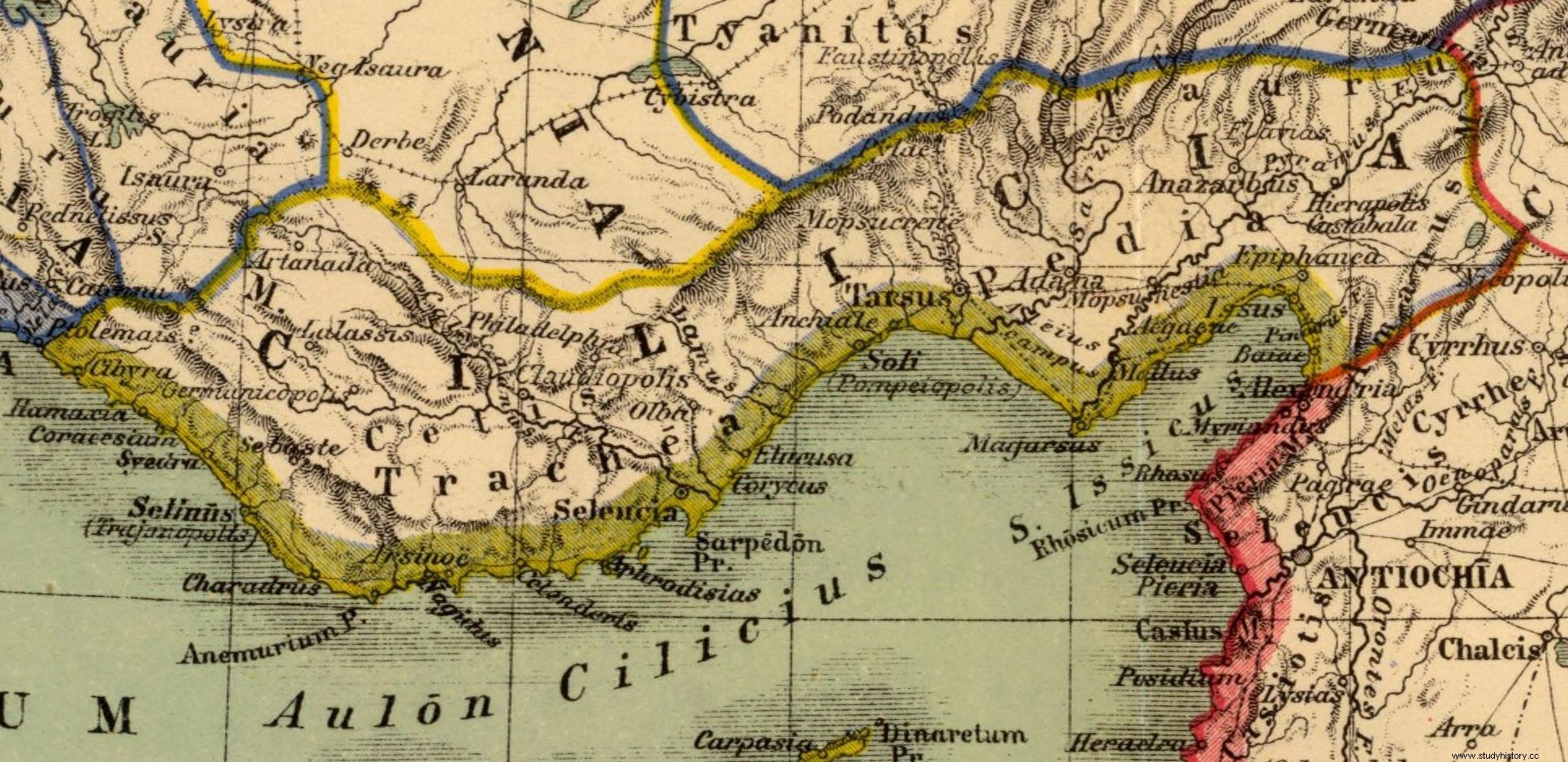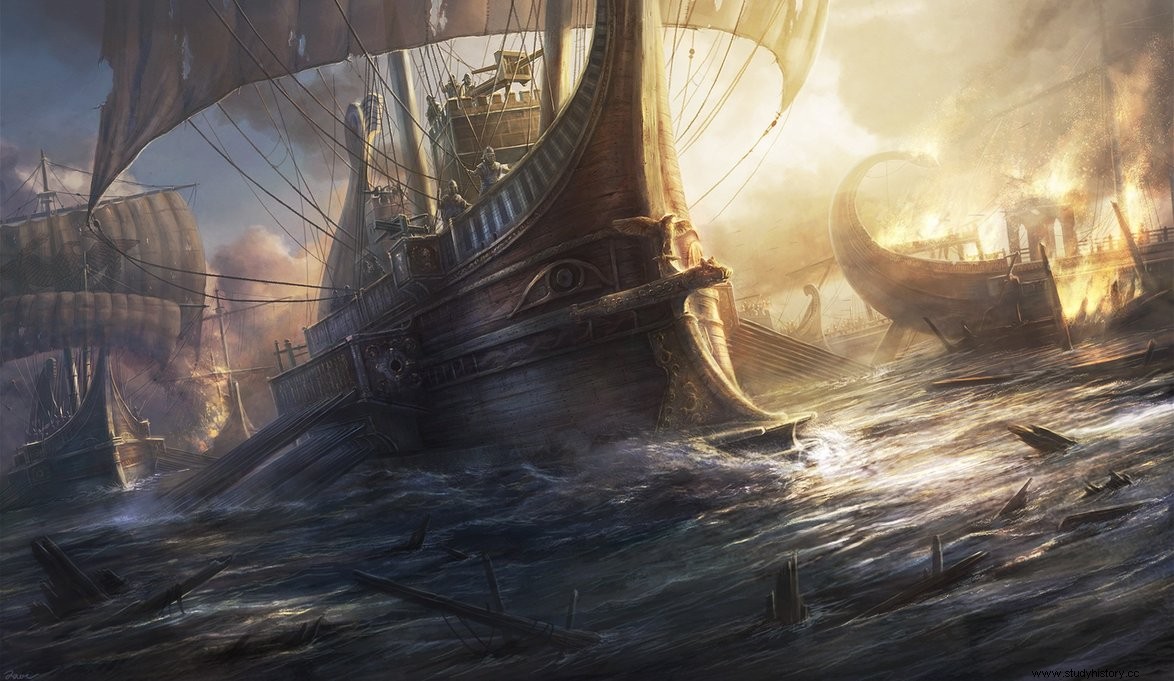I suppose that for the millions of followers of Asterix and Obelix the character of the pirate Barbarossa will not be unknown A captain and crew always up for a beating! Every time they come across Asterix and Obelix, their ship ends up sinking and they end up on driftwood. Well, although René Goscinny and Albert Uderzo were based on the pirates created by Jean-Michel Charlier and Victor Hubinon for their adventure comic Le Démon des Caraïbes (The demon of the Caribbean), due to the time and its scope of action (Mediterranean), could well have been the Cilician pirates and Zeníquetes his Barbarossa.

With the name of Cilicia (in Greek Κιλικία and in Armenian Կիlangelanges) the coastal strip of Anatolia, today Çucurova, in the southeast of present-day Turkey, was known. The interior of the region, then called Cilicia Trachea , is mountainous and rugged, while the coastline, the Cilicia Pedias , is softer, alternating the great river plains at the mouths of the Cidno, Saros and Píramo rivers with sharp cliffs, islands and coves ideal for hiding ships and even entire flotillas. Since the times of the Hittites, Persians and Seleucids, this region has always been a disputed area between great powers, suffering the ravages of war with dramatic recurrence. Perhaps that poverty of cultivated land and farms devastated by the conflicts, added to the scarce fishing in those Mediterranean waters, was what led the inhabitants of this wild area to seek a more adventurous way of life.

Soon those small bands of robbers, grouped in a single ship, or in a few of them, always small and shallow like the liburnae of Illyria and the pinazas and hemiolias from the Aegean islands, began to seek goals more ambitious than looting unsuspecting cargo ships on their cabotage routes. During the first half of the 1st century B.C. Many pirate captains began to take over archipelagos and strategic enclaves, no longer hidden in coves, but located in well-fortified port cities where they established their naval bases outside of Rome, Egypt or whoever tried to prevent their criminal activities. Come on, the forerunners of the Caribbean Turtle Island. They became more and more audacious, not content with robberies and robberies, but creating a financing system based on the kidnapping of rich Romans that worked very well for them. Known is the episode of the kidnapping of a young and arrogant Gaius Julius Caesar when he was on his way to Rhodes ready to complete his education, although in this case it ended in tragedy for his captors.
This is how Plutarch told us in his Life of Pompey the sad end that could await the one who fell into the hands of the Cilician pirates:
But the most outrageous thing was that, captivated by someone, if he said that he was a Roman and gave them his name, they pretended to be startled, and trembling they slapped their thighs, and prostrated themselves before him, telling him to forgive. He believed them, seeing them dismayed and reduced to entreaties; but later, some put his shoes on him, others wrapped him in the toga, so that he would not cease to be known, and having thus ridiculed and mocked him for a long time, they threw the ladder into the water and told him to go down and go happy; and the one who resisted was caught and submerged in the sea.
It is in this precise period when one of the most renowned pirate captains appears on the scene, Zeníquetes , also known as Zenicetus in some ancient sources. It is true that the classical sources portrayed the Cilician pirates with the same contempt that the Greeks once did with the Persians, viciously emphasizing their picturesque mixture of effeminacy, daring and cruelty. Their captains liked expensive and ornate clothes, luxurious weapons, well-groomed and perfumed beards, earrings in their ears and makeup, an image that we would describe today as a bit tacky. His ships did not detract from his sick taste for ostentation:Cilician biremes and triremes sported great purple sails, burnished bronze on their spurs, silver blades on their oars, and dark flags with skulls and crossbones fluttering from their masts. Making a simple extrapolation to Caribbean piracy, these robbers of the seas were no less sophisticated than their English and French heirs of the 17th and 18th centuries, those Cilicians being the first sailors to create a community society where everyone owned everything and the captains did not hold command beyond combat, and could be deposed in assembly by the sailors in case of frank disagreement (despite their love of luxury, they were more communist than Lenin)
From his base in the city of Olympos (today Çıralı, in Antalya, Turkey), Zeníquetes acted on his behalf or under the "letter of marque" of the king Mithridates of Pontus . Sailing between Rhodes and Crete became collective suicide for any commercial ship without a Sinope flag. Each warlord took control of a piece of coastline, his pirate comrade being Nicón the scourge of the ships of the fertile crescent and Zeniquetes that of the eastern Aegean. Hundreds of bitter complaints from looted or kidnapped merchants and landowners poured into the Senate each year. Addressing such an alarming problem, Senator Publio Servilio Vatia he was sent as proconsul to Cilicia in 77 BC. at the head of an army and a large fleet to combat the permanent threat posed by these gangsters of the seas within the commercial development of the republic in the East. After a swift naval victory in which the Roman quinqueremes dismasted the small pirate ships, the war moved to the Lydian coast, each pirate stronghold having to be taken one by one. Perhaps the bloodiest episode was the taking of Olympos , main base of the pirate leader and his last stronghold, assault in which Zeníquetes himself and his men were burned alive before surrendering to the Romans.

After occupying Olympos , Vatia continued in his fierce harassment of piracy by moving his troops from Lydia to Pamphylia. The next target was the natural harbor of Phaselis (today near Kemer, in Antalya), still faithful to Zeníquetes, to culminate his coastal campaign in the important port of Coricos (today Kızkalesi, in Mersin), where he captured the city and imprisoned many pirates, including the feared Nicon. Not content with having eradicated piracy from the entire Cilician coast, in 75 B.C. Vatia undertook a new and successful campaign in the Taurus Mountains, since the surviving pirates had hidden in Isauria, a campaign that earned him the conquest of Cilicia Trachea, the recognition as imperator by his troops and the granting of a triumph by the streets of Rome in which he exhibited his immense loot and his hostage Nicon loaded with chains. All the riches were deposited in the temple of Saturn, because Vatia did not want to keep part of the loot from him, differentiating himself from the rest of the previous proconsuls, always more avid for gold than for national glory. From that day on, the Senate granted him the title of Isaurico.
Unfortunately for Rome, the proconsul did not solve the pirate problem, because with his victories he only got a parenthesis. In 68 BC the audacity of the Cilician pirates came to the climax of him, especially after having defeated the father of Marco Antonio in Crete inflicting severe losses. Free from all Roman naval pressure and sailing freely from Ibiza to Cyprus, in their raids they came to loot Caieta (today Gaeta), Miseno and Ostia, the very port of Rome, spreading their wave of terror throughout the western Mediterranean. It was Pompey the Great who had to take exceptional measures to definitively solve the problem, just as exceptional were the powers of imperium that the Senate and the Lex Gabinia they granted him to eradicate piracy once and for all, not without the clear reluctance of the entire optimate faction of the Senate who saw in these privileges an excessive accumulation of power in a single person. Few senators supported these measures in favor of Pompey from the beginning, among them a certain Gaius Julius Caesar .
As commander-in-chief of all the shores of the Mare Internum fifty miles inland, Pompey divided the sea into thirteen zones, each placing a trusted legate in command of a fleet. His tactic was successful, quick and effective. In just forty days he cleared pirates from the Pillars of Hercules (Strait of Gibraltar) to Sicily. With the west controlled, one by one all the pirate flotillas were massacred by his legates, driving the survivors towards the shores of Cilicia. The last and agonizing battle was fought in front of the city of Coracesio (today Alanya), where, according to the propaganda of the time, Pompey and his two hundred ships sank nearly a thousand enemy ships, a feat that culminated his victorious campaign and in which, according to Plutarch, more than twenty thousand pirates perished and another ten thousand They were captured after the capture of the city.
Changing his strategy during the war, Pompey opted to negotiate with some of the pirate kingpins to give away their comrades' lairs in exchange for their freedom, and perhaps at the mercy of such private pacts not all of those thieves ended up skinned on the cross. Many pirates converted even to Roman citizens ended their days as merchants in the old city of Soli, which was then renamed Pompeiópolis (today in ruins near Kastamonu, Turkey). Years later, after the death of Caesar and the entry on the scene of the triumvirate, some of those old sailors attached to Pompey's clientele would once again represent a problem for the stability of Rome and its new master, Gaius Octavio , but that's another story, and one of the plots of my novel Princeps, the first citizen of Rome :the Sicilian rebellion of Sextus Pompey, the Son of Neptune.
Collaboration of Gabriel Castelló author of Archenemies of Rome
